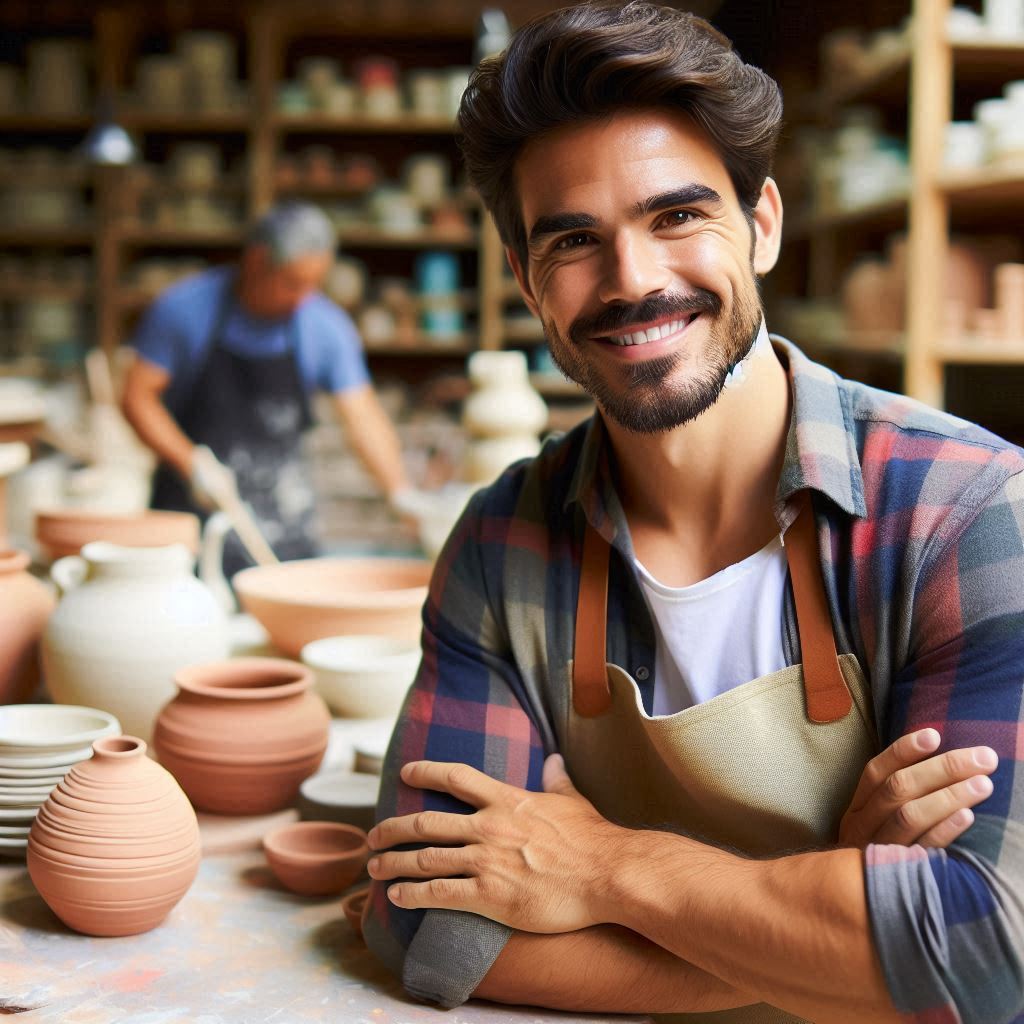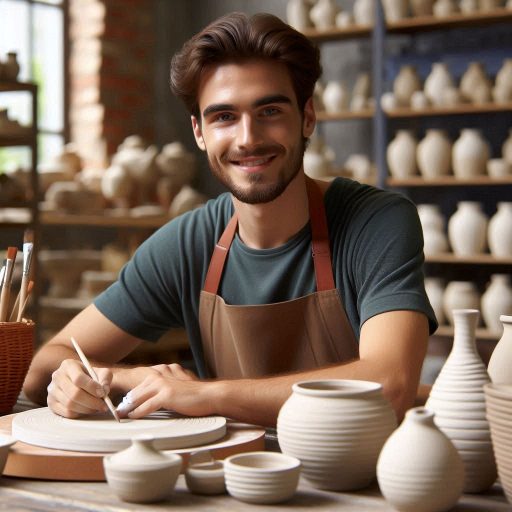Introduction
Starting with ceramics can be both exciting and overwhelming for beginners.
The right tools and materials are crucial for crafting beautiful ceramic art.
Without essential supplies, beginners might struggle to bring their creative visions to life.
Ceramic art involves shaping and firing clay to create stunning pieces.
For beginners, having the correct supplies simplifies the process and enhances their artistic skills.
Quality tools and materials ensure better results and more enjoyable crafting experiences.
Key supplies include clay, pottery tools, and a kiln.
Clay is the foundation of any ceramic project, while pottery tools assist in shaping and detailing.
A kiln is essential for firing ceramics, turning raw clay into durable art.
Each supply plays a unique role in the creative process.
Investing in the right tools helps beginners avoid frustration and improves their technique.
With proper supplies, beginners can experiment with different techniques, leading to more refined and polished pieces.
These supplies not only support the learning process but also contribute to the enjoyment of creating art.
In summary, having the essential supplies is vital for any beginner ceramic artist.
They facilitate learning, enhance skills, and help in creating beautiful and lasting ceramic pieces.
By starting with the right tools, beginners set a solid foundation for their artistic journey in ceramics.
Clay
Types of Clay
- Earthenware, stoneware, porcelain are common options for ceramic artists.
- Each type has unique properties, such as color, texture, and firing range.
- Consider your project needs when selecting the clay type.
Choosing the Right Clay
- Clay affects the final outcome of your ceramic piece.
- Earthenware is suitable for beginners due to its ease of use.
- Stoneware offers durability and is great for functional items.
- Porcelain is best for delicate and intricate designs.
Beginner-Friendly Clay Options
- White earthenware clay is versatile and forgiving for beginners.
- Terra cotta clay is ideal for hand-building and sculpting projects.
- Mid-range stoneware clay is suitable for both beginners and experienced artists.
- Each of these options provides a good foundation for learning ceramic techniques.
Read: Marketing Tips for Ceramic Artists
Pottery Wheel
Role of a pottery wheel in creating ceramic pieces
A pottery wheel is essential for shaping and forming clay into various ceramic pieces.
It provides a rotating surface that helps in creating symmetrical and uniform shapes.
As the wheel spins, the potter can use their hands to mold the clay into forms like bowls, vases, and cups.
Transform Your Career Today
Unlock a personalized career strategy that drives real results. Get tailored advice and a roadmap designed just for you.
Start NowBenefits of using a pottery wheel for shaping and forming clay
Using a pottery wheel offers several benefits.
It allows for greater control over the shape and texture of the piece.
The spinning motion helps achieve even walls and smooth surfaces.
This tool also facilitates intricate designs and fine details that are difficult to achieve by hand.
Affordable and beginner-friendly pottery wheel options
For beginners, there are several affordable and user-friendly pottery wheel options available.
Manual or kick wheels are often less expensive and require physical effort to operate.
They are great for small studios and provide a good introduction to the craft.
Electric wheels, while slightly more costly, are easier to use and require less physical effort.
They are ideal for those who plan to practice frequently.
Brands like Brent and Skutt offer reliable entry-level electric wheels.
They are durable and come with various features suited for beginners.
For those on a tighter budget, consider used wheels or entry-level models from brands like Shimpo or Clay Boss.
Investing in a pottery wheel opens up numerous creative possibilities and enhances your clay work.
Choose a model that fits your budget and space to start exploring the art of ceramics.
Read: Sustainable Practices in Printmaking
Kiln
When it comes to creating ceramic art, a kiln is an essential tool for firing your pieces.
Importance of a Kiln
A kiln is necessary for turning your clay creations into durable, long-lasting ceramic pieces.
Without firing in a kiln, your pieces will remain fragile and easily breakable.
Types of Kilns
There are several types of kilns available to choose from, each serving a specific purpose in the firing process.
- Electric Kilns: Ideal for beginners due to their ease of use and consistent firing temperatures.
- Gas Kilns: Provide a more hands-on firing experience and are often preferred by experienced ceramic artists.
- Raku Kilns: Specifically designed for the raku firing technique, producing unique and vibrant results.
Functions of Different Kilns
Each type of kiln has its own set of functions that cater to the specific needs of ceramic artists.
Transform Your Career Today
Unlock a personalized career strategy that drives real results. Get tailored advice and a roadmap designed just for you.
Start Now- Electric Kilns: Offer precise temperature control, making them suitable for a wide range of ceramic projects.
- Gas Kilns: Allow for a reduction atmosphere, resulting in unique colors and effects on the ceramic surface.
- Raku Kilns: Designed to quickly heat and cool the pieces for the raku firing technique, creating striking crackle patterns.
Tips for Using a Kiln
Properly using a kiln is crucial to the success of your ceramic pieces.
Here are some tips for beginners:
- Read the manual: Familiarize yourself with the specific instructions for your type of kiln.
- Prep your pieces: Ensure your ceramic pieces are completely dry before firing to prevent cracking.
- Follow firing schedule: Pay close attention to the recommended firing schedule for your clay type to achieve the best results.
- Monitor the temperature: Use a pyrometer to track the temperature inside the kiln and make adjustments if necessary.
- Ventilate properly: Proper ventilation is essential to prevent harmful fumes from building up during firing.
With the right kiln and proper techniques, you can bring your ceramic creations to life and unleash your artistic potential.
Read: Famous Ceramic Artists You Should Know

Sculpting Tools
Essential sculpting tools every ceramic artist should have
As a beginner ceramic artist, having the right sculpting tools is essential for creating beautiful and intricate clay pieces.
Here are the essential sculpting tools every ceramic artist should have:
- Loop Tool: Used for cutting and removing clay, shaping and smoothing surfaces, and creating details.
- Ribbon Tool: Perfect for cutting and shaping clay, creating clean lines, and carving details.
- Wire Tool: Ideal for cutting clay, trimming excess material, and creating sharp edges.
- Sponge: Helps in smoothing surfaces, blending clay, and adding texture to your pieces.
- Needle Tool: Great for scoring clay, adding details, and creating fine lines or patterns.
Different functions of each tool in shaping and detailing clay
Each tool serves a specific function in shaping and detailing clay.
The loop tool is versatile for both cutting and shaping clay, while the ribbon tool is excellent for creating precise lines and detailed textures.
The wire tool is perfect for cutting and trimming clay with precision, and the sponge helps in smoothing and blending the clay surface for a flawless finish.
The needle tool is essential for adding intricate details and textures to your clay pieces.
Recommend beginner-friendly sculpting tool kits
For beginner ceramic artists, it is recommended to start with a sculpting tool kit that includes a variety of basic tools to get you started.
These kits often include the essential tools mentioned above, along with additional tools like modeling tools, clay shapers, and scrapers.
Investing in a quality sculpting tool kit will not only make your work easier but also improve the quality of your clay sculptures.
Read: Incorporating Printmaking into Mixed Media Art
Glazes
When it comes to ceramic art, glazes play a crucial role in adding color and texture to ceramic pieces.
Types of Glazes
- Underglazes: These are applied before the final glaze and provide a base color.
- Metallic Glazes: These give a metallic sheen to pottery when fired.
- Raku Glazes: These are known for their unique and unpredictable results.
Each type of glaze has its own characteristics and effects on the finished piece, so it’s important to experiment with different types to achieve the desired results.
Importance of Glazes
Glazes not only add color to ceramic pieces but also provide a protective coating that makes them safe for everyday use.
They can transform a plain piece of pottery into a work of art.
Applying Glazes
For beginners, it’s essential to follow these tips when applying glazes:
- Clean your pottery thoroughly before applying the glaze to ensure smooth and even coverage.
- Use multiple coats of glaze to achieve a more vibrant color and texture.
- Experiment with different techniques such as brushing, dipping, pouring, or spraying to create unique effects.
- Allow each layer of glaze to dry completely before applying the next one to prevent smudging or mixing of colors.
- Refer to the manufacturer’s instructions for firing temperature and duration to ensure the glaze sets properly.
By mastering the art of glazing, beginners can elevate their ceramic pieces and create stunning works of art that reflect their creativity and individual style.
Transform Your Career Today
Unlock a personalized career strategy that drives real results. Get tailored advice and a roadmap designed just for you.
Start NowUncover the Details: The Evolution of Web Design Over the Years
Brushes and Tools for Decorating
When it comes to ceramic art, the quality of your brushes and tools for decorating plays a significant role in creating beautiful and intricate designs on your pieces.
Investing in high-quality brushes and tools is essential for beginners to develop their skills and bring their creative ideas to life.
The Necessity of Quality Brushes and Tools
Quality brushes and tools ensure precision and control while decorating ceramic pieces.
They help in achieving fine details and intricate patterns on the clay surface.
Using the right tools can enhance the overall appearance and aesthetics of your ceramics.
Recommend Specific Tools for Painting, Carving, and Detailing Clay
Here are some specific tools that are essential for painting, carving, and detailing clay:
- Paintbrushes: Invest in a variety of paintbrushes such as round, flat, and liner brushes for different painting techniques.
- Carving Tools: Get a set of carving tools with various tips and shapes to create textures and designs on the clay surface.
- Detailing Tools: Use small brushes, needle tools, and sculpting tools for adding fine details and embellishments to your ceramic pieces.
Different Techniques That Can Be Used with These Tools
There are several techniques that you can explore when decorating ceramic pieces using brushes and tools:
- Painting: Experiment with different brush strokes, blending colors, and layering techniques to create unique designs on your ceramics.
- Carving: Use carving tools to etch patterns, textures, and shapes into the clay surface, adding depth and dimension to your pieces.
- Detailing: Utilize detailing tools to add intricate motifs, textures, and accents to enhance the visual appeal of your ceramics.
By incorporating these techniques and using quality brushes and tools, beginner ceramic artists can elevate their creations and develop their personal style in ceramic art.
Workspace and Storage Supplies
When it comes to ceramic art, having a dedicated workspace is essential for beginners.
It not only helps keep your tools and materials organized but also provides a designated area where you can focus on your artistic projects.
Importance of a Dedicated Workspace
A dedicated workspace allows you to have a designated area where you can work on your ceramic art projects without any distractions.
It helps you stay organized by providing a space where you can keep all your tools, materials, and supplies in one place.
Having a dedicated workspace also helps create a conducive environment for creativity and inspiration to flow freely.
Essential Storage Supplies
- Shelving units or cabinets: These are essential for storing tools, materials, glazes, and finished pieces.
- Storage bins or containers: Use these to store small items like brushes, carving tools, and sculpting tools.
- Label maker or markers: Keep your workspace organized by labeling storage containers for easy identification.
Tips for Setting up an Efficient Workspace
- Choose a well-lit area with good ventilation to ensure a comfortable working environment.
- Invest in a sturdy work table or bench that can withstand the weight of your ceramic projects.
- Keep your workspace clutter-free by regularly cleaning and organizing your tools and materials.
- Create designated zones for different tasks such as sculpting, glazing, and firing to optimize workflow.
- Personalize your workspace with inspiring artwork, plants, or decorations that reflect your creative style.
- Consider investing in ergonomic tools and equipment to prevent injuries and promote better posture while working.
By following these tips and investing in essential storage supplies, you can create a productive and organized ceramic workspace that will help you unleash your creativity and hone your skills as a beginner ceramic artist.
Conclusion
Having essential supplies is crucial for beginner ceramic artists to kickstart their journey.
Investing in quality tools and materials will greatly improve their craft, leading to better results and satisfaction in their work.
As beginners embark on their ceramic art journey, it is important to remember that practice and patience are key.
Taking the time to learn and hone their skills will ultimately lead to growth and success in their artistic endeavors.
So go ahead, gather your essential supplies, and dive into the world of ceramic art with enthusiasm and dedication.
Transform Your Career Today
Unlock a personalized career strategy that drives real results. Get tailored advice and a roadmap designed just for you.
Start NowRemember, the journey may be challenging at times, but the rewards of creating beautiful pieces with your own hands will be well worth it.
Happy creating!




